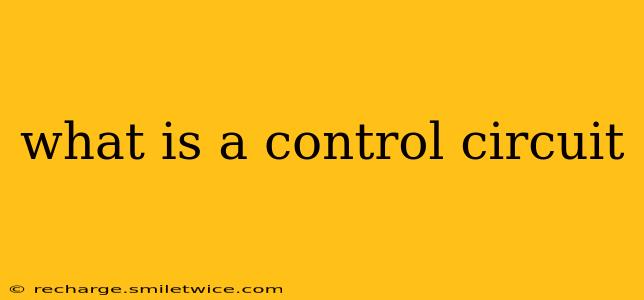A control circuit is the heart of any automated system, responsible for regulating and monitoring the operation of various components to achieve a desired outcome. It's essentially a pathway for electrical signals that dictate the behavior of a device or process, ensuring it functions correctly and safely. Instead of relying on manual intervention, control circuits automate these processes, offering increased efficiency, precision, and safety.
Think of it as the brain of a machine or system—it receives inputs, processes information, and delivers outputs to control the actions of other parts. This intricate network of components works together to manage everything from the simple on/off switching of a light to the complex operations of industrial machinery.
What are the key components of a control circuit?
A typical control circuit incorporates several key components working in harmony:
-
Sensors: These are the eyes and ears of the system. Sensors detect changes in physical quantities like temperature, pressure, light, or motion, converting them into electrical signals that the circuit can understand. Examples include thermistors (temperature), photoresistors (light), and pressure transducers.
-
Control Unit (Controller): This is the brain of the operation, processing the signals received from sensors and making decisions based on pre-programmed instructions or algorithms. This can range from a simple relay to a complex programmable logic controller (PLC) or microprocessor.
-
Actuators: These are the muscles of the system, responsible for carrying out the commands issued by the control unit. They translate electrical signals into physical actions. Examples include motors, solenoids, valves, and relays.
-
Power Supply: This provides the necessary electrical energy to power the entire control circuit and its components.
How does a control circuit work?
The functioning of a control circuit is best understood through a simplified example: Imagine a thermostat controlling a heating system.
-
Sensing: The thermostat (sensor) measures the room temperature.
-
Comparison: The thermostat compares the measured temperature to the setpoint (desired temperature).
-
Decision-making: If the measured temperature is below the setpoint, the thermostat signals the heating system to turn on.
-
Actuation: The heating system (actuator) receives this signal and begins heating the room.
-
Feedback: As the room warms up, the thermostat continues to monitor the temperature. Once the temperature reaches the setpoint, it signals the heating system to turn off. This feedback loop ensures the system maintains the desired temperature.
What are different types of control circuits?
Control circuits come in various types, each suited to specific applications:
-
On/Off Control: The simplest type, where the actuator is either fully on or fully off. Examples include a simple light switch or a thermostat in its most basic function.
-
Proportional Control: The output of the actuator is proportional to the error signal (difference between setpoint and measured value). This provides finer control and smoother transitions than on/off control.
-
PID Control (Proportional-Integral-Derivative): A more advanced form of control that uses three parameters (proportional, integral, and derivative) to fine-tune the control response. This type is commonly used in industrial processes requiring high precision.
What are some common applications of control circuits?
Control circuits are ubiquitous in modern technology, found in diverse applications:
-
Home Automation: Thermostats, lighting systems, security systems.
-
Industrial Automation: Manufacturing processes, robotics, process control systems.
-
Automotive Systems: Engine management, anti-lock braking systems (ABS), electronic stability control (ESC).
-
Aerospace Systems: Flight control systems, navigation systems.
How does a control circuit differ from a power circuit?
While both involve electricity, their functions differ significantly:
-
Control circuits handle low-power signals to control the operation of higher-power components in a power circuit.
-
Power circuits deliver high-power electricity to operate devices and machinery.
What are some common problems with control circuits?
Potential problems can include:
-
Faulty sensors: Incorrect readings lead to improper control actions.
-
Damaged wiring: Interrupts the signal path.
-
Malfunctioning control unit: Incorrect processing of signals.
-
Failed actuators: Inability to carry out control commands.
Understanding control circuits is crucial for anyone working in engineering, automation, or any field involving automated systems. Their ability to automate complex processes with precision and efficiency has revolutionized various industries.
